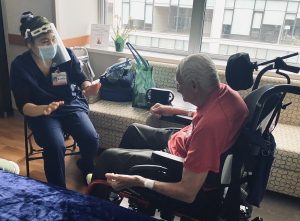Dance is often thought of as a great source of exercise, a practice of self-expression and an outlet for stress. But dance has waltzed its way into a new therapeutic model that lives at the intersection of physical and emotional healing: dance therapy. Magee offers Dance/Movement Therapy (DMT) to inpatients at no cost as part of the Creative Arts Therapy program.
Medicine and Movement Collide
Kristine Keliiliki, dance therapy intern at Magee, just graduated with her Master of Arts in Dance and Movement Therapy Counseling from Drexel University. But, she wasn’t always clear on her career path. “I grew up loving dance so much that I pursued it as my undergraduate degree, but I ended up working in the medical field after graduation when I enrolled in the military,” she shared.
While working in an emergency room, Kristine connected with the art therapist on the base to learn more about what art therapy entailed—that’s when she learned about DMT. “I always thought I would have to choose between medicine and dance, but this is a beautiful marriage of my two passions,” she said.
A Unique Treatment Experience
 While patients at Magee are usually on strict schedules and treatment plans for rehabilitation, dance therapy provides a reprieve from the routine. “I try to meet each patient where they are that day. I want to give them a space to make their own decisions and find what feels right for them,” said Kristine. “When I first start working with a patient, we decide on a movement greeting—like a secret way of saying ‘hello’ between just the two of us. And then every session after we greet each other, I’ll check in and see how that person is doing on that particular day.”
While patients at Magee are usually on strict schedules and treatment plans for rehabilitation, dance therapy provides a reprieve from the routine. “I try to meet each patient where they are that day. I want to give them a space to make their own decisions and find what feels right for them,” said Kristine. “When I first start working with a patient, we decide on a movement greeting—like a secret way of saying ‘hello’ between just the two of us. And then every session after we greet each other, I’ll check in and see how that person is doing on that particular day.”
Kristine’s DMT sessions usually begin with a warm-up, gentle movements, stretching and questions to spark creativity. She then guides patients into their movements for the day, which could include yoga, meditation, choreography or dancing with props. Each session closes with time for reflection.
The Art of Collaboration
Dance therapy represents a unique holistic approach to healing because patients use their bodies as a canvas to express emotions while simultaneously working on their physical health goals—sometimes integrating with speech, physical or occupational therapy. Kristine explained, “We can work on cognitive memory by creating a sequence of dance moves to see if a patient can remember it, and then if they can do it backward. Or, in a more physical aspect, we might put on a patient’s favorite song and sway together to work on weight-shifting.”
Kristine noted that she’s amazed at how dance and movement continually elevates the other therapy work that patients are doing. “Dance therapy strengthens their bodies, but it also helps them with the emotional and mental stress of being in a rehab facility—just to have an outlet and space to let loose, whether they’re feeling frustrated or happy or anything in between.”
Lessons in Disguise
Overall, Kristine said she’s learned more from patients than they have from her. “Listening to their stories and dancing with them has shown me what incredible strength, courage and resilience these patients have,” she said. She also continues to be a strong advocate for the Creative Arts Therapy program at Magee. “It’s an essential part of healing and expression for patients. And it’s been an absolute honor and pleasure to be a small part of these patients’ journeys at Magee.”
Kristine leads a dance/movement therapy session at Magee





